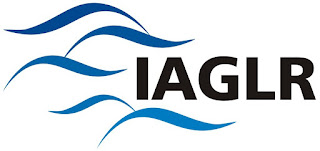Three of IISG’s interns were among the hundreds of scientists, researchers, educators, and more in attendance at last week’s IAGLR 2013 conference. Each of them wrote in to tell us more about their experiences at the conference, and some interesting things they took away from the sessions.
Emily Anderson, interning with IISG’s environmental social scientist Caitie McCoy, learned more about the major issues facing the Great Lakes:
“During the week I spent at the IAGLR conference I gained a greater understanding of how researchers, policy makers, and citizens alike have to be included in the conversation for the Great Lakes to be restored, conserved, and used sustainably. Through the talks I attended I learned a lot about how harmful algal blooms, personal medications, and impermeable surfaces can affect the health of the Great Lakes, but what I found most interesting was witnessing the cooperative efforts between the United States and Canada. I found it so encouraging to watch as representatives from the two countries shared data and other resources to face the challenges affecting the health of the Great Lakes region jointly. The IAGLR conference was a magical experience for me; I saw with my own two eyes the genesis of future policy and research. Most importantly for my position as an IISG intern, I now understand where Sea Grant fits into the equation of Great Lakes protection with research, education, and outreach.”
Allison Neubauer, a Great Lakes education intern working with IISG’s Kristin TePas, was aware of a number of environmental issues, but was still surprised to learn about the wide range of current and potential problems facing the Great Lakes:
“The greatest take-away from my week at IAGLR would have to be the myriad issues affecting the Great Lakes, and the critical importance of continued research and education to addressing them. In spite of my general understanding of environmental science and the Great Lakes, I was woefully under-informed about the more-than-50 different issues that had entire sessions devoted to them.
For this reason, my favorite part was sitting in on the educator-scientist roundtable discussion. The goal was to bring real issues into the classroom with place-based learning. Teachers and researchers alike proposed many exciting ideas for incorporating Great Lakes research into science lessons. It was awesome to see how enthusiastic educators were about collaborating with scientists and going the extra mile to make science more relevant and fun for students. In my mind this was the most important facet of the IAGLR conference because students need to be exposed to real, current issues surrounding them and affecting the vital resources of the Great Lakes. I think this collaborative effort could spark career-building education for future scientists and very possibly inspire them to be Great Lakes researchers giving their own talks at an IAGLR conference years from now.”
Cait Lackey, who will be working with Greg Hitzroth and the IISG aquatic invasive species team, was excited to learn more about the many areas where Sea Grant works to help protect and preserve the Great Lakes:
“Prior to the IAGLR conference my knowledge about the Great Lakes was limited. At the conference I learned that there are a multitude of issues facing the Great Lakes, many of which I wasn’t familiar with. Some of my favorites included the effects that the Great Lakes have on tourism, marketing strategies for invasive species in the Great Lakes, and the use of landscape architecture for restoration ecology.
At IAGLR I also learned about the various roles Sea Grant plays in protecting the health of the Great Lakes. Just from meeting other Sea Grant employees and interns and hearing some of their presentations, I learned that the Sea Grant staff works to educate many people and audiences including teachers, students, fisherman, local residents, and retailers. I also learned that Sea Grant staff works to research and present solutions to problems the Great Lakes currently face. I had the opportunity to see presentations given by Sea Grant Staff that involved a great deal of research and development, and attending the IAGLR conference showed me that the work Sea Grant participates in is detailed, diverse, and at times very challenging.”
Find out more about IAGLR and the annual conference at the link above, and follow IAGLR on Twitter as well.


